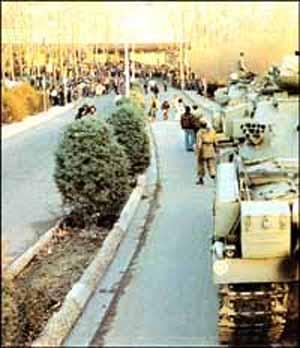General Ramtin's Account of How to Store Weapons
Compiled by: Islamic Revolution Website
Translated by: Fazel Shirzad
2024-10-29
I remember that we were in Bakhtiar's Palace on the night of 22 Bahman (10th February). There was also wireless telephone. Two or three of my colleagues and I were in the telephone room, and according to the words of the police officers whose wireless telephone was on; We heard that the police station fell down somewhere, the police station fell down here and there. Then we talked and said to come and get Bakhtiar tonight. Bakhtiar belonged to the upper class. Another thing is that there is a police station at the first of Jami Street, which was called "Center Police Station" at that time. On the wireless telephone, we could hear an officer saying that people have dropped, what should I do with the guns? The one who was talking to him said: I don't know what to do. He said: I can keep two or five of them, what should I do with the rest? This issue made me think about the storage of weapons and that we should keep and preserve these weapons in any way possible. Then with some colleagues, we started to bring weapons and collected them and appointed some people to guard them; because we heard that the people of the gangs had brought a number of Afghans and told them to go and get whatever weapons and ammunition there are and bring them and we will give you two thousand tomans (Iranian currency). Later, the issues that the hypocrites raised for the revolution probably originated from here. Well, that's what we came up with after hearing that wireless and figured out what to do in that situation. Of course, before these talks happen at all; the army was with the people and had no problem with them. We thank God, we did it, and Alhamdulillah, not a single needle point was lost from our weapons and we used all of them twice. Six days had passed since the victory of the revolution; That is, on February 28, I was at home at two in the morning when they said that Sanandaj was crowded.

I got up at two o'clock and came, ten or twelve of these comrades, some of whom have now been martyred, I called and they came with guns and a truck. In short, we used the same weapons in the missions that happened in Sanandaj and in other places.[1]
[1] Source: Oral History of the Army in the Islamic Revolution, edited by Heshmatullah Azizi, Tehran, Islamic Revolution Documentation Center, 2016, pp. 97-98.
Number of Visits: 1320








The latest
- Objects Tell What Happened in the Eight-Year War!
- 100 Questions/6
- Comparative Analysis of Women’s and Men’s Written Memoirs in the Sacred Defense
- The Importance of Pre-Publication Critique of Oral History Works
- Third Regiment: Memoirs of an Iraqi Prisoner of War Doctor – 6
- 100 Questions/5
- Complete Harmony Between Narrator and Author; the Defining Hallmark of “Beyond the Wall”
- Pepper Fragrance
Most visited
- Third Regiment: Memoirs of an Iraqi Prisoner of War Doctor – 5
- Complete Harmony Between Narrator and Author; the Defining Hallmark of “Beyond the Wall”
- Challenges of Interviewing in Oral History
- Pepper Fragrance
- 100 Questions/5
- Third Regiment: Memoirs of an Iraqi Prisoner of War Doctor – 6
- 100 Questions/6
- The Importance of Pre-Publication Critique of Oral History Works
Mohammad — The Messiah of Kurdistan
Boroujerdi immediately said to Darvish, “Ready a few men; we’re going.” Then he moved toward Mostafa, who was studying the Kurdistan map. Mostafa straightened his back and said, “During my service in the army I experienced a full-scale war in Kurdistan. Guerrilla warfare in Kurdistan follows its own rules. The anti-revolutionary commanders want to draw us into a battle chosen on their terms.”From Javanrud to Piranshahr
The Memoir of Reza MohammadiniaThe book From Javanrud to Piranshahr recounts the life and struggles of Commander Reza Mohammadinia, who spent part of the Iran–Iraq War in the western and northwestern regions of the country. During those years, he held responsibilities such as deputy commander of the Seventh Region of the Islamic Revolutionary Guard Corps (IRGC), acting head of the Javanrud district, service on the southern fronts, director of ...
Tactical and Strategic Analysis and Limitations
The present paper, entitled “A Critical and Scholarly Study of Dr. Hossein Alaei’s Two-Volume Book: Tactical and Strategic Analysis and Limitations”, is a research work that examines and evaluates the two-volume book “An Analytical History of the Iran-Iraq War”. In this study, the strengths and weaknesses of the work are analyzed from the perspectives of content critique, methodology, and sources.

